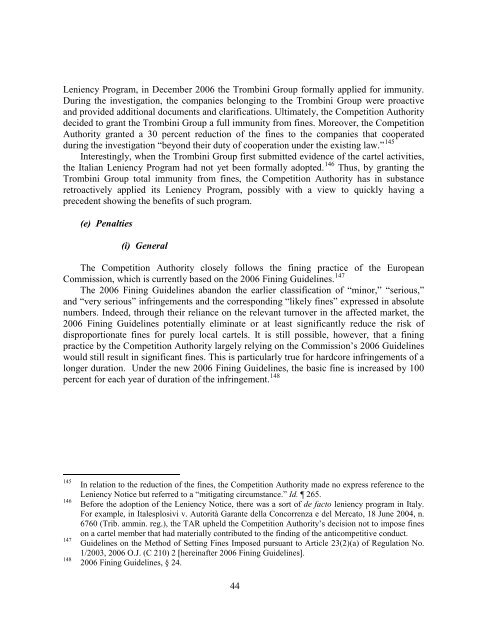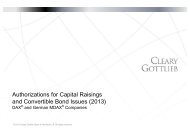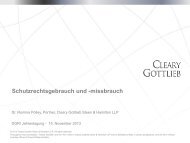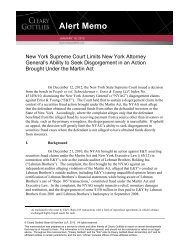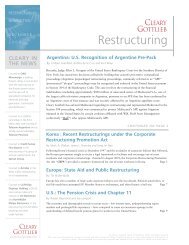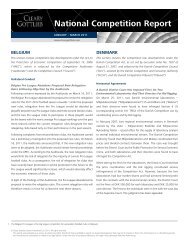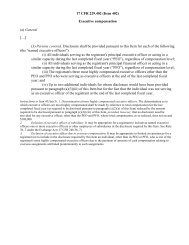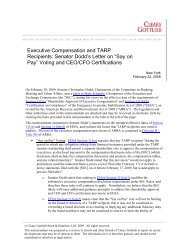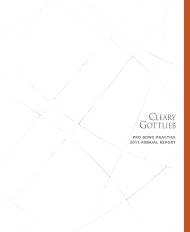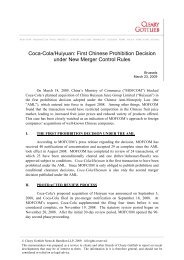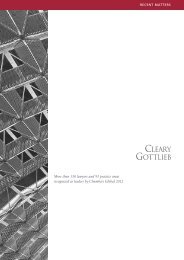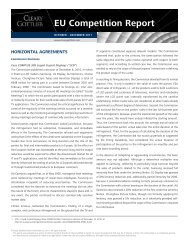Competition Law in Italy The first 20 years of law and practice
Competition Law in Italy The first 20 years of law and practice
Competition Law in Italy The first 20 years of law and practice
You also want an ePaper? Increase the reach of your titles
YUMPU automatically turns print PDFs into web optimized ePapers that Google loves.
Leniency Program, <strong>in</strong> December <strong>20</strong>06 the Tromb<strong>in</strong>i Group formally applied for immunity.<br />
Dur<strong>in</strong>g the <strong>in</strong>vestigation, the companies belong<strong>in</strong>g to the Tromb<strong>in</strong>i Group were proactive<br />
<strong>and</strong> provided additional documents <strong>and</strong> clarifications. Ultimately, the <strong>Competition</strong> Authority<br />
decided to grant the Tromb<strong>in</strong>i Group a full immunity from f<strong>in</strong>es. Moreover, the <strong>Competition</strong><br />
Authority granted a 30 percent reduction <strong>of</strong> the f<strong>in</strong>es to the companies that cooperated<br />
dur<strong>in</strong>g the <strong>in</strong>vestigation “beyond their duty <strong>of</strong> cooperation under the exist<strong>in</strong>g <strong>law</strong>.” 145<br />
Interest<strong>in</strong>gly, when the Tromb<strong>in</strong>i Group <strong>first</strong> submitted evidence <strong>of</strong> the cartel activities,<br />
the Italian Leniency Program had not yet been formally adopted.<br />
44<br />
146<br />
Thus, by grant<strong>in</strong>g the<br />
Tromb<strong>in</strong>i Group total immunity from f<strong>in</strong>es, the <strong>Competition</strong> Authority has <strong>in</strong> substance<br />
retroactively applied its Leniency Program, possibly with a view to quickly hav<strong>in</strong>g a<br />
precedent show<strong>in</strong>g the benefits <strong>of</strong> such program.<br />
(e) Penalties<br />
(i) General<br />
<strong>The</strong> <strong>Competition</strong> Authority closely follows the f<strong>in</strong><strong>in</strong>g <strong>practice</strong> <strong>of</strong> the European<br />
Commission, which is currently based on the <strong>20</strong>06 F<strong>in</strong><strong>in</strong>g Guidel<strong>in</strong>es. 147<br />
<strong>The</strong> <strong>20</strong>06 F<strong>in</strong><strong>in</strong>g Guidel<strong>in</strong>es ab<strong>and</strong>on the earlier classification <strong>of</strong> “m<strong>in</strong>or,” “serious,”<br />
<strong>and</strong> “very serious” <strong>in</strong>fr<strong>in</strong>gements <strong>and</strong> the correspond<strong>in</strong>g “likely f<strong>in</strong>es” expressed <strong>in</strong> absolute<br />
numbers. Indeed, through their reliance on the relevant turnover <strong>in</strong> the affected market, the<br />
<strong>20</strong>06 F<strong>in</strong><strong>in</strong>g Guidel<strong>in</strong>es potentially elim<strong>in</strong>ate or at least significantly reduce the risk <strong>of</strong><br />
disproportionate f<strong>in</strong>es for purely local cartels. It is still possible, however, that a f<strong>in</strong><strong>in</strong>g<br />
<strong>practice</strong> by the <strong>Competition</strong> Authority largely rely<strong>in</strong>g on the Commission’s <strong>20</strong>06 Guidel<strong>in</strong>es<br />
would still result <strong>in</strong> significant f<strong>in</strong>es. This is particularly true for hardcore <strong>in</strong>fr<strong>in</strong>gements <strong>of</strong> a<br />
longer duration. Under the new <strong>20</strong>06 F<strong>in</strong><strong>in</strong>g Guidel<strong>in</strong>es, the basic f<strong>in</strong>e is <strong>in</strong>creased by 100<br />
148<br />
percent for each year <strong>of</strong> duration <strong>of</strong> the <strong>in</strong>fr<strong>in</strong>gement.<br />
145 In relation to the reduction <strong>of</strong> the f<strong>in</strong>es, the <strong>Competition</strong> Authority made no express reference to the<br />
Leniency Notice but referred to a “mitigat<strong>in</strong>g circumstance.” Id. 265.<br />
146 Before the adoption <strong>of</strong> the Leniency Notice, there was a sort <strong>of</strong> de facto leniency program <strong>in</strong> <strong>Italy</strong>.<br />
For example, <strong>in</strong> Italesplosivi v. Autorità Garante della Concorrenza e del Mercato, 18 June <strong>20</strong>04, n.<br />
6760 (Trib. amm<strong>in</strong>. reg.), the TAR upheld the <strong>Competition</strong> Authority’s decision not to impose f<strong>in</strong>es<br />
on a cartel member that had materially contributed to the f<strong>in</strong>d<strong>in</strong>g <strong>of</strong> the anticompetitive conduct.<br />
147 Guidel<strong>in</strong>es on the Method <strong>of</strong> Sett<strong>in</strong>g F<strong>in</strong>es Imposed pursuant to Article 23(2)(a) <strong>of</strong> Regulation No.<br />
1/<strong>20</strong>03, <strong>20</strong>06 O.J. (C 210) 2 [here<strong>in</strong>after <strong>20</strong>06 F<strong>in</strong><strong>in</strong>g Guidel<strong>in</strong>es].<br />
148 <strong>20</strong>06 F<strong>in</strong><strong>in</strong>g Guidel<strong>in</strong>es, § 24.


